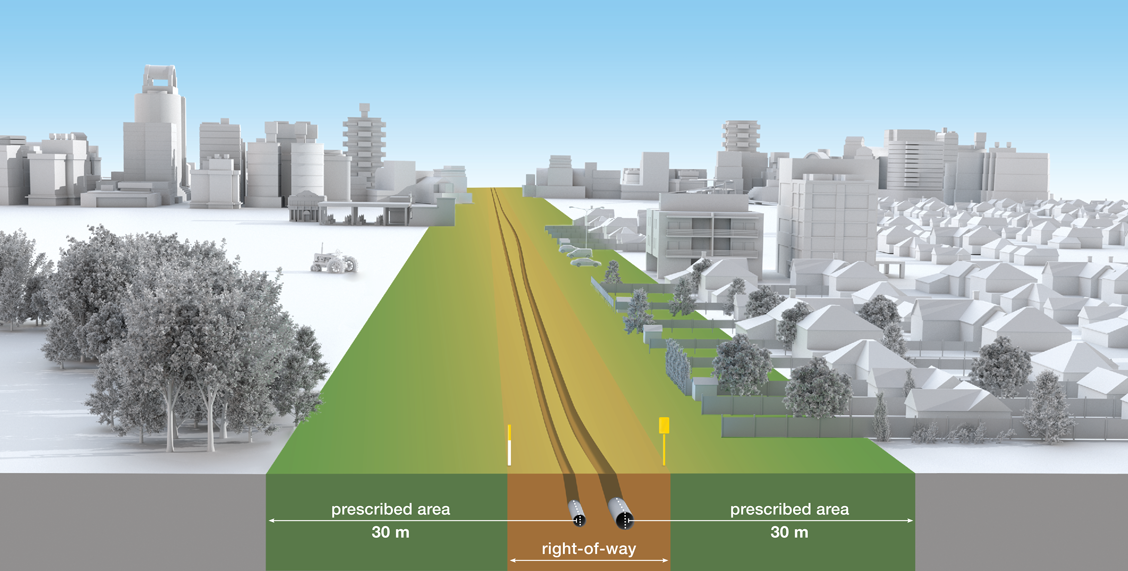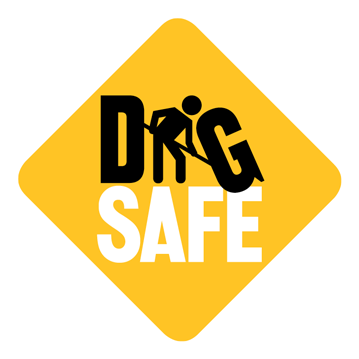Agricultural Activities

View the full Agricultural Activities Near Pipelines booklet online, or download a printable PDF [7907 KB]
Who this is for
This page is for farmers, ranchers, market gardeners, tree farmers, sod growers, landscapers, orchardists, vineyard operators, and other agricultural producers.
On this page
- Activities and equipment
- Working in the prescribed area: what you need to know
- For those living and working near pipelines
- What agricultural activities do not need consent in the prescribed area
- What agricultural activities need consent from the pipeline company
- Constructing a facility
- Agricultural vehicles and equipment in the prescribed area
- Which agricultural crossings need consent
- Agreeing to activities and costs
- Get help from the CER to reach agreements
- If you don’t follow the regulations
- Monitoring the right-of-way
- Terms to know
- Related publications, regulations, and guidance
- Damage prevention resources
Activities and equipment
Your activities may include:
- deep tillage,
- farm drain tiling
- laser-levelling
- sub-soiling
- building fences
- installing irrigation
See a list of agricultural vehicles...
- planting equipment
- tillage equipment
- chemical applicators
- harvesters
Working in the prescribed area: what you need to know

Prescribed Area Description
The prescribed area is a requirement in regulations prescribing an area for the purposes of safety and security. This area requires extra precaution, communication, and consent from the pipeline company for some activities.
It is measured 30 m outward on both sides from the centreline of the pipe. If there is more than one pipeline in the right-of-way, the prescribed area is measured from the outermost pipelines on each side.
Activities and equipment in the prescribed area are regulated for safety, and to prevent contact with and damage to the pipe.
Working within the prescribed area
You must get written consent from the pipeline company for:
- any activity that digs 30 cm or deeper within the prescribed area
- cultivation to a depth of 45 cm or deeper (examples this applies to are on the agriculture page)
The pipeline company has to make sure that the activities won’t damage the pipe. If the pipeline company consents to your activities, they must give you the information to do your activities safely. You need this information for your own safety, and the safety of the public and the environment.
Note: if the pipeline company does not consent to your activities, you can get help from the CER. For details, see agreeing to activities and costs.
Right-of-way description
The right-of-way is the strip of land for which a company has obtained the right to construct and operate a pipeline. The width of the right-of-way varies according to the size, routing and number of pipelines. The area of the right-of-way is usually smaller than the prescribed area.
Working within the right-of-way
When your activity is closer to the pipeline, there are more safety requirements. Within the right-of-way, you must get the pipeline company’s written consent before you dig or build anything, such as an outbuilding, fence, or even a sandbox.
You must get written consent from the pipeline company authorizing the following within the right-of-way:
- any activity that digs 30 cm or deeper (applies in the prescribed area as well as the ROW)
- cultivation to a depth of 45 cm or deeper (examples this applies to are on the agriculture page)
- building anything
- driving vehicles or mobile equipment off of a road way, over a pipeline
- placing or storing anything on the right-of-way, including a berm, wood pile, or a parked vehicle
More details about the prescribed area...
The depth of soil cover over the pipeline can be shallower in some places than others. This can be caused by issues like compaction, activities, soil removal, ground settling, wind erosion, and flooding.
Along with federally regulated pipelines, there may be facilities such as provincially and locally regulated pipelines and cables in your work area. These may include oil and gas field gathering pipes, gas distribution systems, fibre optic communications cables, water and sewer lines, and electrical cables. Know what's below. Contact Click Before You Dig.
See DPR – Authorizations, section 2.
Pipeline signs or markers are placed in visible locations along the right-of-way. They tell you a pipeline is in the area, but not its exact location.
For those living and working near pipelines
Know what's below. In addition to federally regulated pipelines, there may be other provincially and locally regulated pipelines and cables in your area. These facilities may include oil and gas field gathering pipes, gas distribution systems, fibre-optic cables, water and sewer lines, and electrical cables.
See the steps to take before starting any activity that disturbs the soil 30 cm (12 in) or deeper below the surface...
- Don't just dig. Plan ahead. It can take time to locate the pipes and cables and to get written consent, if needed.
- Look for pipeline marker signs in your area, and check land records for easements.
- Contact Click Before You Dig or a one-call centre to locate underground pipes and cables. You may need to be on site when the technician comes.
- Get written consent from the pipeline company before any ground disturbance that is 30 cm (12 in) or deeper.
- You must give everyone the safety information they need: contractors, subcontractors, family members, volunteer helpers, and employees.
What agricultural activities do not need consent in the prescribed area
These agricultural activities are allowed without consent from the pipeline company:
- cultivating less than 45 cm (18 in) deep below the surface
- disturbing the soil less than 30 cm (12 in) deep if it does not reduce the earth cover over the pipeline below the level when the pipeline was constructed
It may not be possible to determine the original depth of soil cover provided when the pipeline was constructed. If the activity results in the reduction of the current depth of earth cover over the pipeline, it is a ground disturbance.
Normal activities such as disking, ploughing, seeding, and harvesting can go ahead so long as they do not reduce the depth of soil over the pipeline.
The pipeline company must notify you if some areas must be avoided because of safety or security concerns.
However, you must contact the pipeline company if you plan to cross the prescribed area with very heavy vehicles or equipment off a public roadway. For more about crossing a pipeline with vehicles and equipment, read Agricultural vehicles and equipment in the prescribed area
What agricultural activities need consent from the pipeline company
Any cultivation that disturbs the soil in the prescribed area 45 cm (18 in) or deeper below the surface requires written consent from the pipeline company.
Other than cultivation, activities that disturb the soil 30 cm (12 in) or deeper also require consent. It may take up to 10 working days to obtain consent.
You can find more information about these activities in Activities in the prescribed area that require consent from the pipeline company.
Examples of activities that cause a ground disturbance...
Activities that cause a ground disturbance can include, but are not limited to:
- driving fence posts, bars, rods, pins, anchors, or pilings
- deep tillage
- subsoiling
- tiling
- excavation
- trenching
- ditching
- augering
- topsoil stripping
- land levelling/grading
- plowing to install irrigation
- tree planting
- clearing and stump removal
- crossing of buried pipelines or other underground infrastructure by heavy loads off the travelled portion of a public roadway
Constructing a facility
The pipeline company must consent if you plan to construct a facility on, along, under, or across the right-of-way. For pipeline safety reasons, your easement agreement likely has conditions in it prohibiting the construction of a facility on the right-of-way. Pipeline company consent is required because a facility may affect the safety or integrity of the pipe.
To see examples of facilities, read the section Facility.
Agricultural vehicles and equipment in the prescribed area
Most conventional agricultural equipment and vehicles can operate normally in low-risk areas of the prescribed area. Consent for vehicle crossing is not required if it happens on a public roadway
However, some of the larger equipment and vehicles may be too heavy. The maximum load depends on both the axle weight and the tire pressure or ground pressure. The pipeline company can help you determine the maximum load.
What affects crossing pipelines...
Government regulations for crossing buried pipelines with vehicles and equipment are based on the best available science, engineering practices, and experience.
What affects pipeline safety can be complex. The factors include, but are not limited to:
- type of activities being conducted
- type and size of equipment
- soil conditions
- frequency of the crossings
- pipeline system specifications and design
- pipeline operating conditions
- pipeline depth of cover
Which agricultural crossings need consent
You must obtain consent if:
- the vehicles or equipment do not meet requirements for axle weight, tire pressure or ground pressure
- the point of crossing has been the subject of a notification from the pipeline company that a crossing at that location could impair the pipeline’s safety or security
Rules for crossing pipelines with vehicles...
If the vehicle crossing is not for an agricultural activity, land users must obtain written consent from the pipeline company before crossing the right-of-way. Consent is also required for crossing with heavy agricultural vehicles and equipment identified by the pipeline company.
Pipeline companies are required to manage vehicle crossings on the pipeline. They must have damage prevention programs in place. These programs must identify vehicles that pose a hazard, and those that do not pose a hazard, and manage them accordingly. If necessary, the pipeline company may request that the location of the crossing be moved or reinforced in some manner to prevent damage.
The pipeline company has 10 working days to inform a person requesting consent for crossing the pipeline right-of-way with an agricultural vehicle or equipment whether it consents to the crossing. If the pipeline company denies consent, the company must give the reasons for the denial to the person making the request.
A thorough assessment of pipeline safety requires detailed knowledge about ground conditions, design factors, and operating characteristics. For these reasons, pipeline companies and landowners or land users need to work together to make crossing assessments.
If you are unable to obtain the consent of the pipeline company for the crossing, you may file an application with the CER. You can find information in Guide C of the CER Filing Manual about how to make an application for a pipeline crossing. You can also contact the CER toll free by telephone at 1-800-899-1265 or by email at DPinfo@cer-rec.gc.ca. For information on how to make an application, read Get help from the CER to reach agreements.
Agreeing to activities and costs
The CER encourages you and the pipeline company to reach an agreement regarding activities within the prescribed area, or for crossing a pipeline. The pipeline company must give written consent for certain activities within the prescribed area. If costs result from authorized projects or work, both you and the pipeline company should agree on how to address those costs.
If you and the pipeline company cannot reach an agreement on costs or terms of work, you can both seek help from the CER.
Get help from the CER to reach agreements
If you and the pipeline company cannot reach an agreement, the CER can help. We offer 2 options to help you:
- Using Alternative Dispute Resolution to negotiate an agreement
- Filing a Section 335 application to address:
- ground disturbance and associated cost apportionment
- facility construction and associated cost apportionment
- vehicle or mobile equipment crossings near federally regulated pipelines
Read about options for managing disagreements...
Using the CER’s Alternative Dispute Resolution service
If you and the pipeline company cannot come to an agreement, you can both contact the CER for assistance. We offer an Alternative Dispute Resolution (ADR) service, a voluntary and confidential way for those involved to resolve disputes. Both you and the pipeline company must agree to participate in ADR.
To learn more, visit Alternative Dispute Resolution.
Filing a section 335 application
Section 335 applications are for filings related to:
- ground disturbance and associated cost apportionment
- facility construction and associated cost apportionment
- vehicle or mobile equipment crossings near federally regulated pipelines
Cost apportionment addresses costs directly incurred as a result of authorized construction and ground disturbance. It relates to negotiating terms of work and who pays for associated costs.
The CER encourages parties to reach agreements on terms of work or associated costs using ADR. If you or the pipeline company cannot reach an agreement using ADR, or one party does not agree to use ADR, the CER can help.
Either you or the pipeline company can file a section 335 application. The CER will hold a formal process to determine the matter and make a decision. For more information and to get started, see:
If you don’t follow the regulations
If the CER Act and its regulations are not followed, critical safety issues may occur, either immediately or over time. For example, a person may strike the line while conducting an activity near a pipeline if they do not make a locate request or contact the pipeline company for details and information on how to work safely near the pipe. Contact with the coating on the pipeline may damage the pipe’s protection from corrosion and cause a leak or rupture in the future.
Violating the Act and its regulations can lead to fines and penalties. Damage to the pipe must be reported to the pipeline company. The pipeline company must report damage to the CER.
Ensure you follow the regulations.
An activity is unauthorized and illegal if the regulations are not followed.
You must get authorization and safety information from the pipeline company for:
- an activity that causes a ground disturbance in the prescribed area
- constructing a facility near a pipeline
- driving across a pipeline off a roadway with vehicles or mobile equipment
The CER may enforce against unauthorized activities for the safety of all involved.
Court Action
Violations of CER can also lead to either a summary conviction or conviction on an indictment. The penalties for these convictions are:
- On conviction on indictment, to a fine not exceeding $1 million or to imprisonment for a term not exceeding 5 years or to both.
- On summary conviction, to a fine not exceeding $100,000 and or to imprisonment for a term not exceeding 1 year or to both.
Click here for more information on enforcing the regulations.
Monitoring the right-of-way
Pipeline companies must monitor land use in order to mitigate potential damage that could occur on or near pipelines. The companies must put a process in place to monitor activities near their pipeline.
They must also develop, implement and maintain a damage prevention program. The damage prevention program is to anticipate, prevent, manage and mitigate damage to pipelines.
Pipeline companies must monitor their pipelines in order to respond to unexpected situations. Monitoring could involve keeping check by air or by land. The pipeline company must take immediate action for anything that could:
- endanger life
- cause substantial property damage
- cause damage to the environment
Pipeline companies must also respond quickly to:
- ground disturbances within the prescribed area
- operation of vehicles or mobile equipment across a pipeline
Related publications, regulations, and guidance
Agricultural Activities Near Pipelines
Pipeline Damage Prevention Regulations—What You Need to Know
Living and Working Near Pipelines
Damage Prevention Regulations — Authorizations
Guidance Notes — Regulations for Pipeline Damage Prevention
Damage prevention resources
Organizations across Canada have joined to help you plan your work safely. Click any of the logos below to visit their sites and find out how they can help you.
- Date modified:



